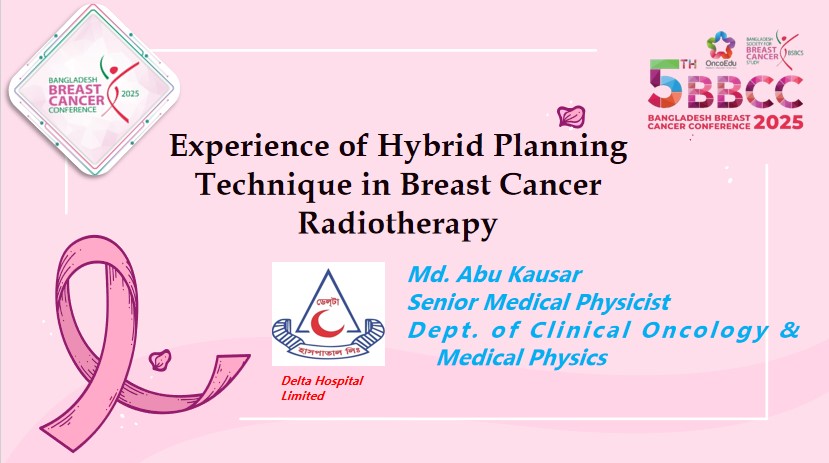Experience of Hybrid Planning Technique in Breast Cancer Radiotherapy
Authors: Abu Kausar1, Morsheda Alam1, Abdul Mazed1, M Shariful Islam2
Institution: 1Delta Hospital Limited, Dhaka, Bangladesh 2National Institute of Cancer Research & Hospital, Dhaka, Bangladesh
Introduction
Radiotherapy for left-sided breast cancer poses unique challenges due to the proximity of critical organs at risk (OARs), such as the heart and lungs. Achieving precise dose distribution is essential to minimize toxicity while ensuring adequate tumor coverage. This study aims to evaluate dosimetric tradeoffs, dose weighting, and the feasibility of hybrid volumetric-modulated arc therapy (H-VMAT) in combination with conventional 3D conformal radiotherapy (3DCRT) for left-sided breast cancer.
Methods
A cohort of 10 left-sided breast cancer patients who underwent adjuvant radiotherapy was analyzed. For each patient, three distinct radiotherapy plans—3DCRT, VMAT-alone, and H-VMAT—were generated. The H-VMAT plans included varying dose weightings: 80% 3DCRT/20% VMAT, 70% 3DCRT/30% VMAT, 60% 3DCRT/40% VMAT, and 50% 3DCRT/50% VMAT. These plans were compared based on planning target volume (PTV) dose coverage, conformity, homogeneity, and dosimetric parameters for OARs. Key metrics analyzed included the mean heart dose, ipsilateral lung mean dose, V4Gy, V10Gy, and V20Gy, as well as the mean dose to the contralateral lung and breast. Treatment delivery times for all plans were also assessed.
Results
All H-VMAT plans demonstrated PTV dose coverage, dose conformity, and homogeneity compared to 3DCRT and VMAT-alone plans. Optimal H-VMAT weighting achieved a balanced tradeoff between target coverage and OAR sparing in heart and lung doses compared to field-in-field 3DCRT or VMAT-alone approaches. Additionally, H-VMAT achieved favorable treatment efficiency without compromising critical organ sparing.
Conclusion
In conclusion, hybrid VMAT planning for left-sided breast cancer radiotherapy offers significant advantages in dosimetric outcomes and critical organ protection. The combination of clinical effectiveness, treatment efficiency, and ease of implementation supports H-VMAT as a practical and optimal solution for managing left-sided breast cancer.
